Farm Dairy effluent - managing stormwater
The intrusion of stormwater into treatment ponds decreases their efficiency by:
- Reducing the retention time of effluent within the system. A minimum 90 days retention time is necessary for effective treatment.
- Lowering the pond’s temperature. This affects essential bacteria and algae which thrive at warmer temperatures.
- Flushing poorly treated effluent through the system into the receiving waters.
- Solids carry over from pond to pond resulting in poor system performance until the ponds are cleaned.
NOTE:
With an annual rainfall of 1200mm and a building/yards runoff area of 250m2, up to 300 cubic metres of clean water can be added to the treatment system.
Many methods are used to divert water from the buildings and yards away from the treatment system after the yard is cleaned. Here are some examples.
1. Sump and upstand
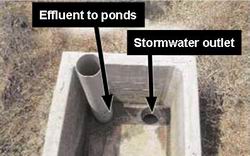 Pipe upstand is moved to channel effluent to the ponds or stormwater to drain. This image shows diverter in stormwater mode.
Pipe upstand is moved to channel effluent to the ponds or stormwater to drain. This image shows diverter in stormwater mode.
2(i). West Coast Chute
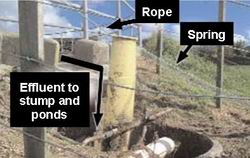 Effluent Mode: The rope is tied at the yard rail, and is accessible from the quad. The spring pulls the chute to stormwater position when the rope is released.
Effluent Mode: The rope is tied at the yard rail, and is accessible from the quad. The spring pulls the chute to stormwater position when the rope is released.
2(ii). West Coast Chute
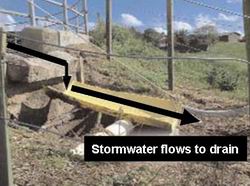 Stormwater mode.
Stormwater mode.
3. Rotating "Y"
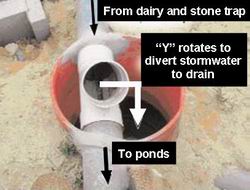 "Y" rotates to divert stormwater.
"Y" rotates to divert stormwater.
4. “Y” with spade
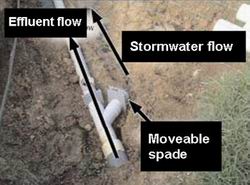 The spade is moved to select either “stormwater” or “effluent” mode.
The spade is moved to select either “stormwater” or “effluent” mode.
5. Automatic
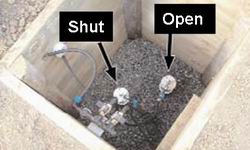 Solenoid actuated diversion valves operated remotely from the dairy. As they are some distance away and below ground a position indicator would be advisable.
Solenoid actuated diversion valves operated remotely from the dairy. As they are some distance away and below ground a position indicator would be advisable.
6. Feedpad
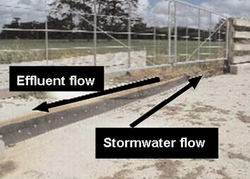 Feed pad diverter. The board is removed to channel effluent to ponds when pad is in use.
Feed pad diverter. The board is removed to channel effluent to ponds when pad is in use.
Catchment stormwater
Stormwater from the surrounding land must be diverted away from the treatment system. Do this by using either channels or bunds around the treatment system.
Operation of stormwater diversion systems
It is essential that good management practice is followed to optimise the performance of the effluent treatment system and to avoid the accidental discharge of untreated effluent to the stormwater drain. To be effective the use of the stormwater diversion system must be part of the daily routine.
Signs, coloured boards or flags visible from a distance can be used to indicate the position of the diversion system.
Further information
For all farm dairy effluent enquiries contact the Whangārei office:
36 Water St, Private Bag 9021, Whāngārei 0140.
Ph (09) 470 1200
Freephone: 0800 002 004
Email: info@nrc.govt.nz
